New Zealand Insulin Drugs & Devices Market Size
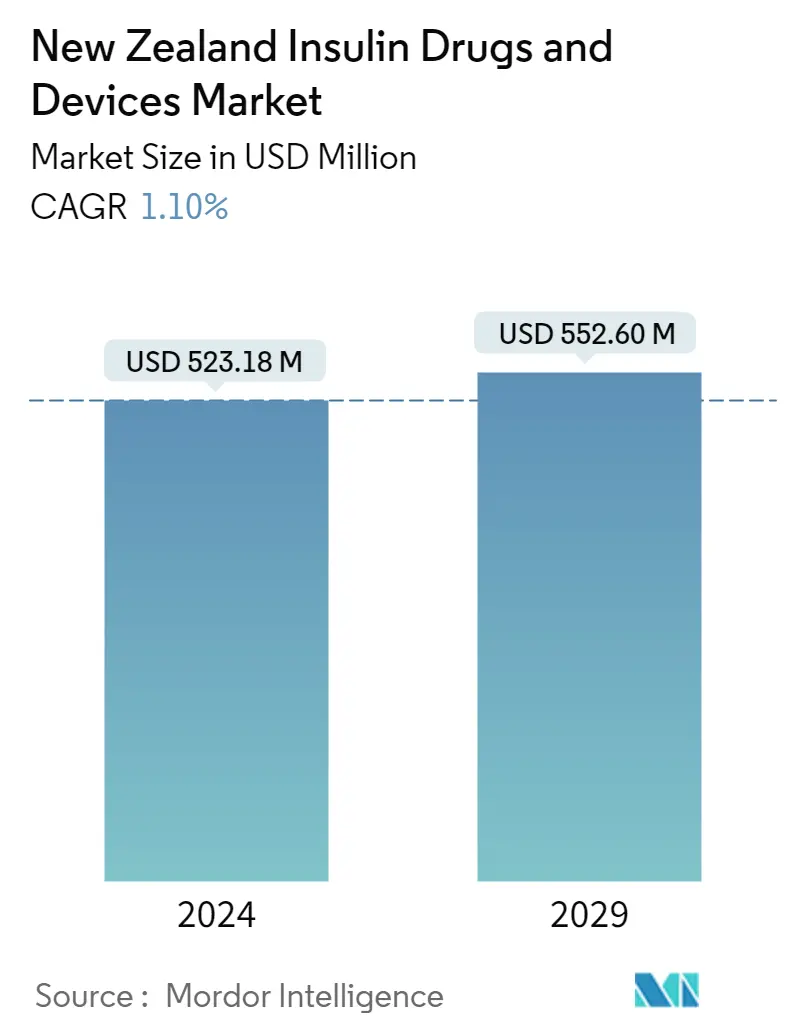
| Study Period | 2019 - 2029 |
| Base Year For Estimation | 2023 |
| Forecast Data Period | 2024 - 2029 |
| Market Size (2024) | USD 523.18 Million |
| Market Size (2029) | USD 552.60 Million |
| CAGR (2024 - 2029) | 1.10 % |
Major Players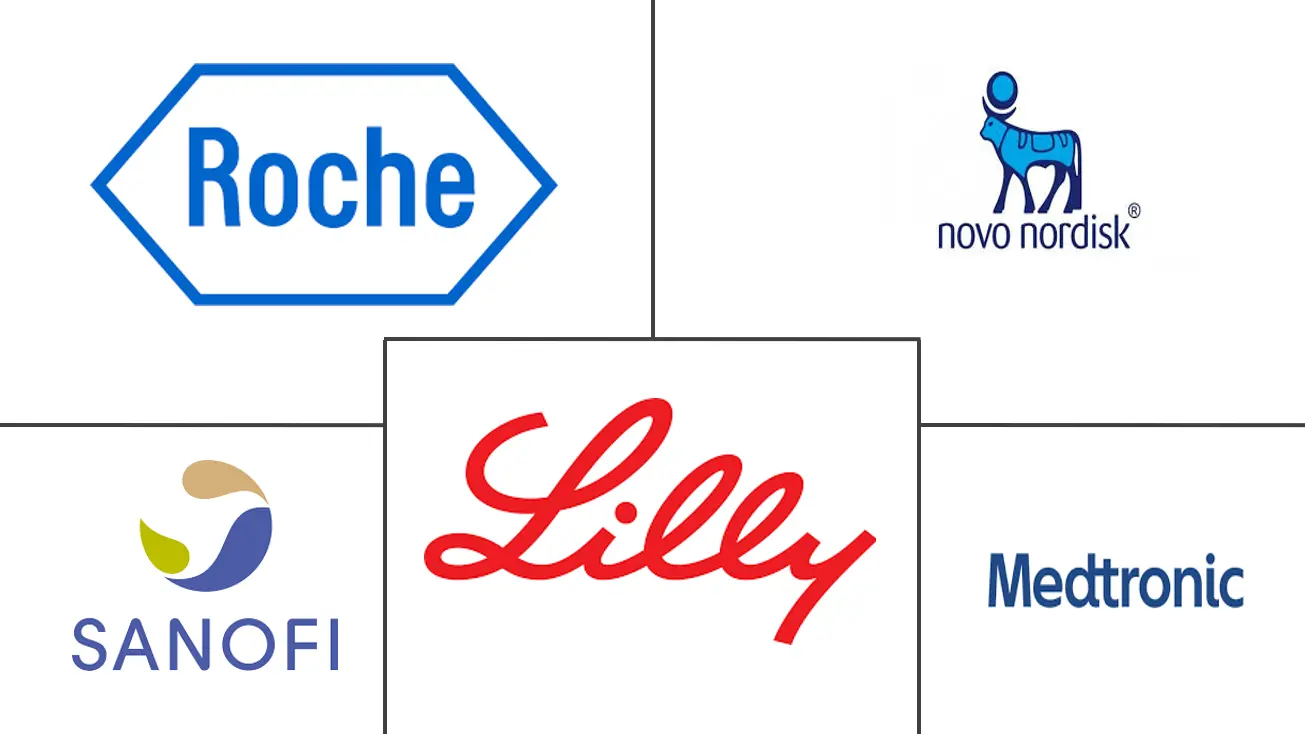
*Disclaimer: Major Players sorted in no particular order |
New Zealand Insulin Drugs & Devices Market Analysis
The New Zealand Insulin Drugs and Devices Market size is estimated at USD 523.18 million in 2024, and is expected to reach USD 552.60 million by 2029, growing at a CAGR of 1.10% during the forecast period (2024-2029).
After COVID-19 was detected, the risk of developing type 1 diabetes increased. The largest risk was in young pediatric and older adult patients with COVID-19. Type 1 diabetic patients were more likely to become infected with the virus and suffer from potentially fatal complications such as diabetic ketoacidosis. It was vital that patients had access to diabetic services and received high-quality clinical treatment, which included diabetes screening, education, and monitoring of complications and control.
To control blood sugar levels, the hormone insulin stimulates the liver, muscle, and fat cells to absorb glucose from the blood. It makes it easier for cells to absorb glucose for cellular energy use. Type 1 diabetes develops when the pancreas cannot produce enough insulin to meet the body's requirements.
Diabetes is typically regarded as a disease connected to lifestyle. The prevalence of the disease has dramatically increased over time due to the rising global population. All those with Type 1 diabetes and between 10% and 25% of those with Type 2 diabetes, totaling around 100 million individuals worldwide, require insulin. More than half of the people in New Zealand who need insulin today still do not have access to it or can afford it, even though insulin has been used to treat diabetes for more than 90 years. Insulin Patients with type-1 diabetes need drugs and delivery systems since their bodies cannot make insulin independently; those with type-2 diabetes also need insulin, especially if they are having trouble controlling their diabetes with oral meds.
New Zealand Insulin Drugs & Devices Market Trends
Rising diabetes prevalence
Type-1 diabetes has an unknown specific origin, whereas type-2 diabetes is brought on by daily lifestyle decisions and adjustments. Compared to ten years ago, the prevalence rate of type-2 diabetes has quadrupled. Over the past 20 years, type 1 diabetes mellitus (T1DM) has become much more common. This rise in frequency is largely attributable to the rise in obesity, which is the main risk factor for T1DM. Diabetes is one of the chronic diseases with the fastest growth rate in the US. One of the top three nations with a high incidence of diabetes in India. Based on lifestyle choices, numerous reports and surveys have shown a sharp rise in the population of people with diabetes.
Healthcare services in New Zealand are frequently separated into "primary care" and "secondary care." Most people often attend primary care as their first source of care. Typically, this is your family doctor or general practitioner. Although patients are required to pay for this service, those with low incomes frequently qualify for a discounted cost. In New Zealand, all children under the age of six can see a doctor without paying a fee. GP visits typically cost between NZ 45 and NZ 55, depending on the physician. There is no extra fee for visitors from other nations for a GP visit. After seeing their physician, patients may be referred to secondary care, typically considered specialized treatment. Specialist diabetes, specialist eye, specialist renal, and hospital services are just a few examples of the services typically managed out of the major hospitals. Patients can request a referral to specialized diabetic services if they are having any issues with their diabetes or, in some cases, if they use insulin for their diabetes. Although the expert services are free, some diabetes doctors also have private practices.
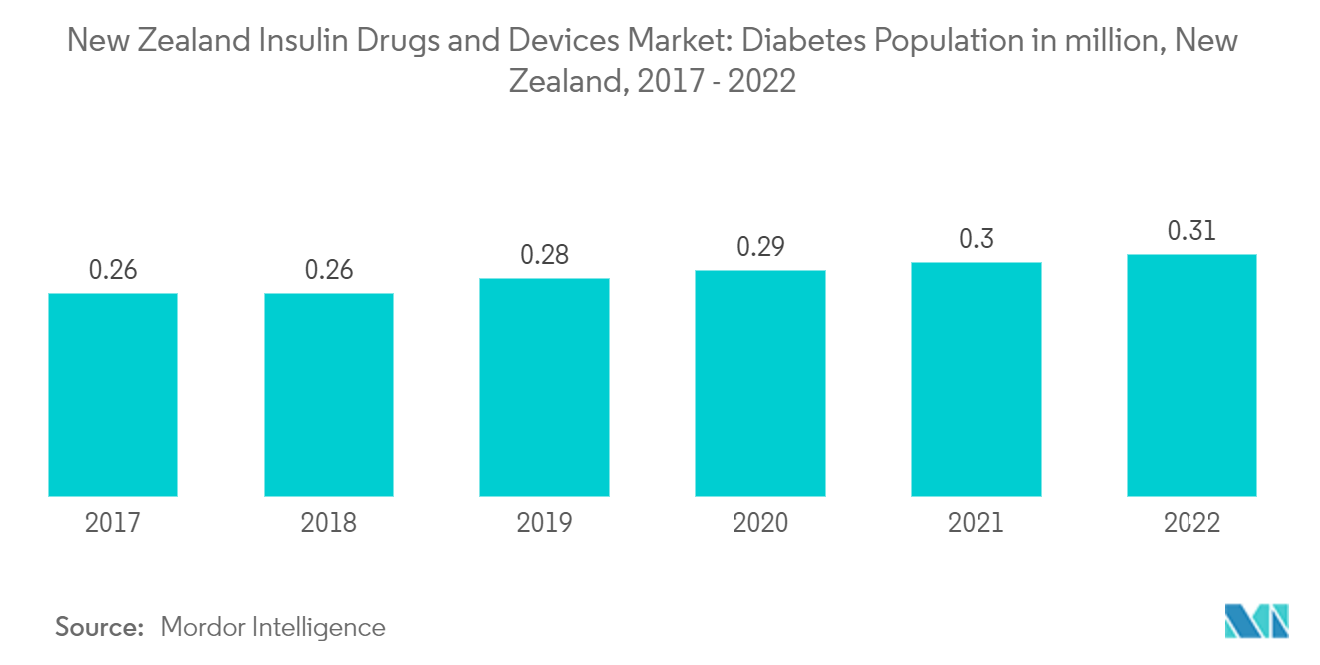
Insulin Drugs segment Expected to Witness Highest Growth Rate Over the Forecast Period
The Insulin Drugs are expected to grow with a CAGR of more than 4% in the market during the forecast period.
The Ministry of Health helped the New Zealand Society for the Study of Diabetes (NZSSD) release type 2 diabetes management guidelines recently, and they state that while the Special Authority criteria for empagliflozin and dulaglutide ensure access for those at high risk of cardiovascular and renal disease, the funding restriction is not entirely consistent with best practice. Public hospital departments offer free treatment for any complications or problems associated with diabetes. Except for New Zealand, the available therapeutic alternatives are comparable to those in every other developed country.
The types of diabetes medications sold in New Zealand are regulated by a government agency called Pharmac. As a result, New Zealand cannot access several pharmaceuticals that are supplied elsewhere. Nevertheless, there is frequently a medicine on the market that is almost identical. You can get insulin and practically all diabetes treatments in New Zealand. Novo Nordisk and Eli Lilly, the leading insulin producers, each has a wide range of goods available in New Zealand. Two widely available very short-acting insulin analogs are Novo Nordisk NovoRapid and Eli Lilly Humalog. Medication costs are the same throughout New Zealand. In New Zealand, each prescription medication will set you back USD 5.00. The roll-out of many new products, increasing international research collaborations in technology advancement, and increasing awareness about diabetes among people are expected to boost the market.
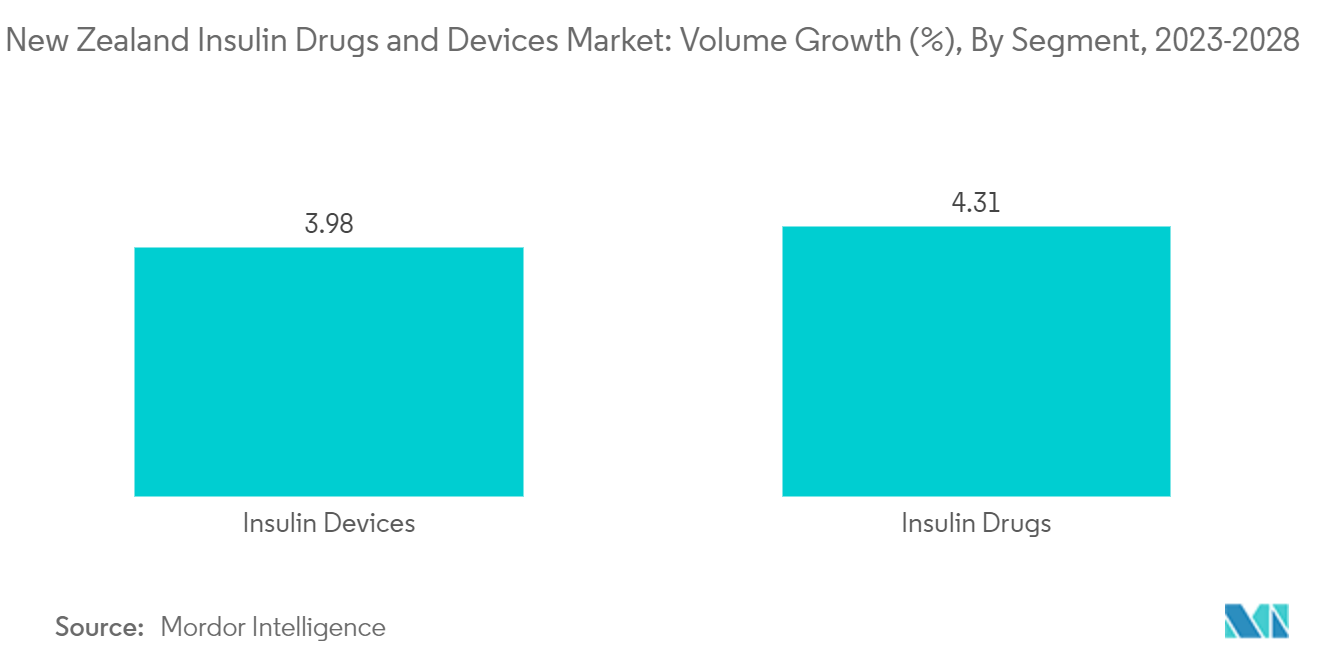
New Zealand Insulin Drugs & Devices Industry Overview
The New Zealand Insulin Drugs and Devices Market is moderately consolidated with few significant and generic players. The major players are working on innovations in insulin drugs and devices which is evident from the companies spending on research and developments to strengthen their market presence.
New Zealand Insulin Drugs & Devices Market Leaders
-
Roche
-
Novo Nordisk
-
Sanofi
-
Eli Lily
-
Medtronic
*Disclaimer: Major Players sorted in no particular order
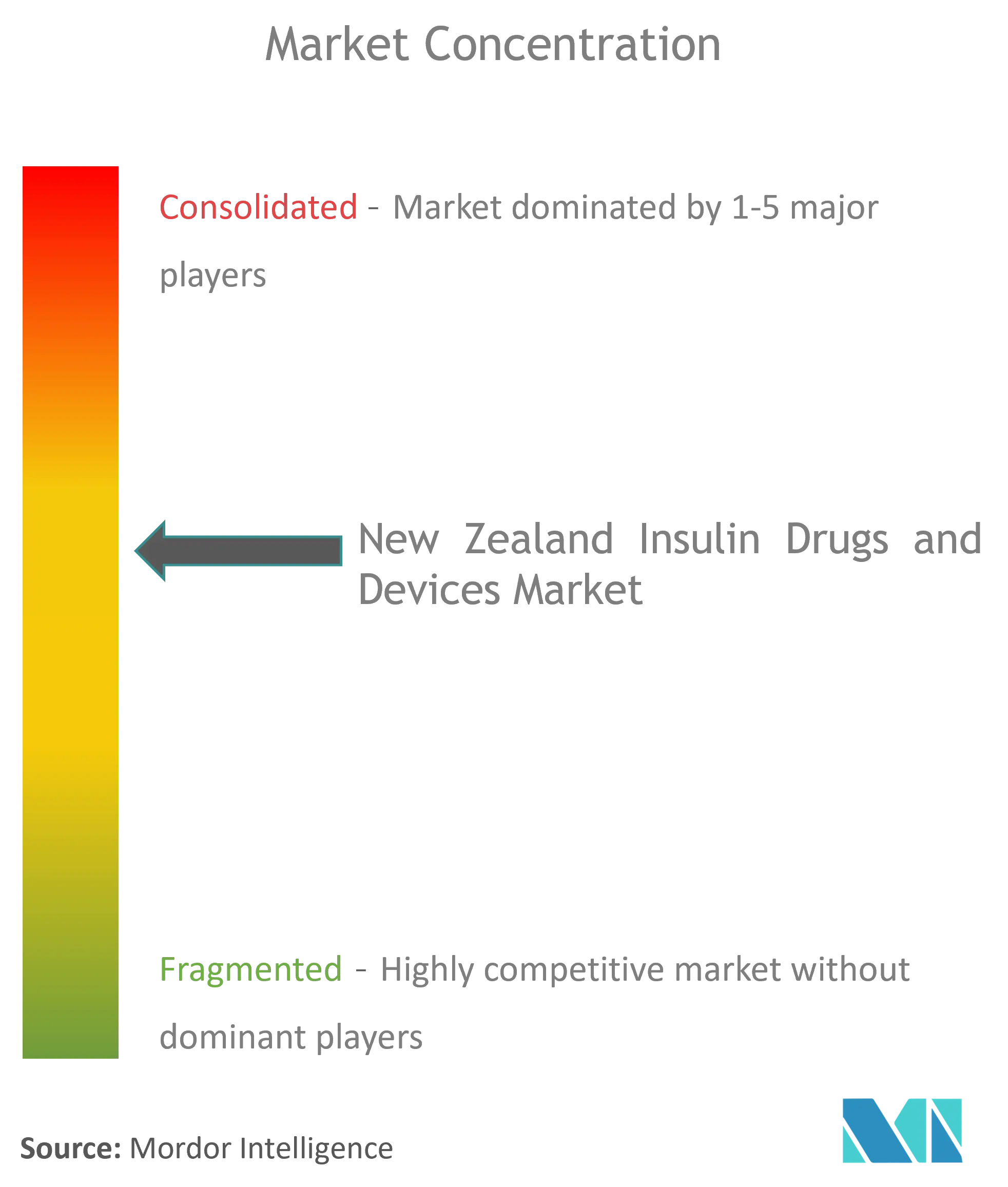
New Zealand Insulin Drugs & Devices Market News
August 2021: Pharmac approved funding for Empagliflozin and Dulaglutide for 53,000 patients with the disease who met certain criteria in December. But the funding for Dulaglutide depended on Medsafe approving the use of the drug.
August 2021: Pharmac launched the 'You Are a Priority' campaign to raise awareness amongst Māori and Pacific people about their ability to access Empagliflozin and Dulaglutide.
New Zealand Insulin Drugs & Devices Market Report - Table of Contents
1. INTRODUCTION
- 1.1 Study Assumptions and Market Definition
- 1.2 Scope of the Study
2. RESEARCH METHODOLOGY
3. EXECUTIVE SUMMARY
4. MARKET DYNAMICS
- 4.1 Market Overview
- 4.2 Market Drivers
- 4.3 Market Restraints
-
4.4 Porter's Five Forces Analysis
- 4.4.1 Bargaining Power of Suppliers
- 4.4.2 Bargaining Power of Consumers
- 4.4.3 Threat of New Entrants
- 4.4.4 Threat of Substitute Products and Services
- 4.4.5 Intensity of Competitive Rivalry
5. MARKET SEGMENTATION
-
5.1 Insulin Drugs (Value and Volume, 2017 - 2028)
- 5.1.1 Basal or Long Acting Insulins
- 5.1.1.1 Lantus (Insulin Glargine)
- 5.1.1.2 Levemir (Insulin Detemir)
- 5.1.1.3 Toujeo (Insulin Glargine)
- 5.1.1.4 Tresiba (Insulin Degludec)
- 5.1.1.5 Basaglar (Insulin Glargine)
- 5.1.2 Bolus or Fast Acting Insulins
- 5.1.2.1 NovoRapid/Novolog (Insulin Aspart)
- 5.1.2.2 Humalog (Insulin Lispro)
- 5.1.2.3 Apidra (Insulin Glulisine)
- 5.1.3 Traditional Human Insulins
- 5.1.3.1 Novolin/Actrapid/Insulatard
- 5.1.3.2 Humulin
- 5.1.3.3 Insuman
- 5.1.4 Biosimilar Insulins
- 5.1.4.1 Insulin Glargine Biosimilars
- 5.1.4.2 Human Insulin Biosimilars
-
5.2 Combination drugs (Value and Volume, 2017 - 2028)
- 5.2.1 Insulin combinations
- 5.2.1.1 NovoMix (Biphasic Insulin Aspart)
- 5.2.1.2 Ryzodeg (Insulin Degludec and Insulin Aspart)
- 5.2.1.3 Xultophy (Insulin Degludec and Liraglutide)
- 5.2.2 Oral Combinations
- 5.2.2.1 Janumet (Sitagliptin and Metformin)
-
5.3 Non-Insulin Injectable drugs (Value and Volume, 2017 - 2028)
- 5.3.1 GLP-1 receptor agonists
- 5.3.1.1 Victoza (Liraglutide)
- 5.3.1.2 Byetta (Exenatide)
- 5.3.1.3 Bydureon (Exenatide)
- 5.3.1.4 Trulicity (Dulaglutide)
- 5.3.1.5 Lyxumia (Lixisenatide)
- 5.3.2 Amylin Analogue
- 5.3.2.1 Symlin (Pramlintide)
-
5.4 Insulin Device (Value and Volume, 2017 - 2028)
- 5.4.1 Insulin Pumps
- 5.4.1.1 Insulin Pump Devices
- 5.4.1.2 Insulin Pump Reservoirs
- 5.4.1.3 Insulin Infusion sets
- 5.4.2 Insulin Pens
- 5.4.2.1 Cartridges in reusable pens
- 5.4.2.2 Disposable insulin pens
- 5.4.3 Insulin Syringes
- 5.4.4 Insulin Jet Injectors
6. MARKET INDICATORS
- 6.1 Type-1 Diabetic Population (2017 - 2028)
- 6.2 Type-2 Diabetic Population (2017 - 2028)
7. COMPETITIVE LANDSCAPE
-
7.1 COMPANY PROFILES
- 7.1.1 Takeda
- 7.1.2 Novo Nordisk
- 7.1.3 Pfizer
- 7.1.4 Eli Lilly
- 7.1.5 Janssen Pharmaceuticals
- 7.1.6 Astellas
- 7.1.7 Boehringer Ingelheim
- 7.1.8 Merck And Co.
- 7.1.9 AstraZeneca
- 7.1.10 Bristol Myers Squibb
- 7.1.11 Novartis
- 7.1.12 Sanofi
- *List Not Exhaustive
8. MARKET OPPORTUNITIES AND FUTURE TRENDS
** Subject To AvailablityNew Zealand Insulin Drugs & Devices Industry Segmentation
With the assistance of the Ministry of Health, the NZSSD has established national current, evidence-based recommendations for the management of type 2 diabetes in adults. All health professionals working with persons with type 2 diabetes in New Zealand will find the guidance a clear, practical resource. It will be updated as new research becomes available and clinical practice evolves. The New Zealand Insulin Drugs and Devices Market is set to witness a CAGR of more than 3% during the forecast period. New Zealand Insulin Drugs and Devices Market is segmented into drugs (Basal or Long-acting Insulins, Bolus or Fast-acting Insulins, Traditional Human Insulins, Combination Insulins, Biosimilar Insulins, and Amylin Analogues) and devices (Insulin Pens, Insulin Pumps, Insulin Syringes, and Jet Injectors) and the report offers the value (in USD million) and volume (in million mL) for drugs and volume (in unit million) for devices.
| Insulin Drugs (Value and Volume, 2017 - 2028) | Basal or Long Acting Insulins | Lantus (Insulin Glargine) |
| Levemir (Insulin Detemir) | ||
| Toujeo (Insulin Glargine) | ||
| Tresiba (Insulin Degludec) | ||
| Basaglar (Insulin Glargine) | ||
| Insulin Drugs (Value and Volume, 2017 - 2028) | Bolus or Fast Acting Insulins | NovoRapid/Novolog (Insulin Aspart) |
| Humalog (Insulin Lispro) | ||
| Apidra (Insulin Glulisine) | ||
| Insulin Drugs (Value and Volume, 2017 - 2028) | Traditional Human Insulins | Novolin/Actrapid/Insulatard |
| Humulin | ||
| Insuman | ||
| Insulin Drugs (Value and Volume, 2017 - 2028) | Biosimilar Insulins | Insulin Glargine Biosimilars |
| Human Insulin Biosimilars | ||
| Combination drugs (Value and Volume, 2017 - 2028) | Insulin combinations | NovoMix (Biphasic Insulin Aspart) |
| Ryzodeg (Insulin Degludec and Insulin Aspart) | ||
| Xultophy (Insulin Degludec and Liraglutide) | ||
| Combination drugs (Value and Volume, 2017 - 2028) | Oral Combinations | Janumet (Sitagliptin and Metformin) |
| Non-Insulin Injectable drugs (Value and Volume, 2017 - 2028) | GLP-1 receptor agonists | Victoza (Liraglutide) |
| Byetta (Exenatide) | ||
| Bydureon (Exenatide) | ||
| Trulicity (Dulaglutide) | ||
| Lyxumia (Lixisenatide) | ||
| Non-Insulin Injectable drugs (Value and Volume, 2017 - 2028) | Amylin Analogue | Symlin (Pramlintide) |
| Insulin Device (Value and Volume, 2017 - 2028) | Insulin Pumps | Insulin Pump Devices |
| Insulin Pump Reservoirs | ||
| Insulin Infusion sets | ||
| Insulin Device (Value and Volume, 2017 - 2028) | Insulin Pens | Cartridges in reusable pens |
| Disposable insulin pens | ||
| Insulin Device (Value and Volume, 2017 - 2028) | Insulin Syringes | |
| Insulin Jet Injectors |
New Zealand Insulin Drugs & Devices Market Research FAQs
How big is the New Zealand Insulin Drugs and Devices Market?
The New Zealand Insulin Drugs and Devices Market size is expected to reach USD 523.18 million in 2024 and grow at a CAGR of 1.10% to reach USD 552.60 million by 2029.
What is the current New Zealand Insulin Drugs and Devices Market size?
In 2024, the New Zealand Insulin Drugs and Devices Market size is expected to reach USD 523.18 million.
Who are the key players in New Zealand Insulin Drugs and Devices Market?
Roche, Novo Nordisk, Sanofi, Eli Lily and Medtronic are the major companies operating in the New Zealand Insulin Drugs and Devices Market.
What years does this New Zealand Insulin Drugs and Devices Market cover, and what was the market size in 2023?
In 2023, the New Zealand Insulin Drugs and Devices Market size was estimated at USD 517.49 million. The report covers the New Zealand Insulin Drugs and Devices Market historical market size for years: 2019, 2020, 2021, 2022 and 2023. The report also forecasts the New Zealand Insulin Drugs and Devices Market size for years: 2024, 2025, 2026, 2027, 2028 and 2029.
New Zealand Insulin Drugs and Devices Industry Report
Statistics for the 2024 New Zealand Insulin Drugs and Devices market share, size and revenue growth rate, created by Mordor Intelligence™ Industry Reports. New Zealand Insulin Drugs and Devices analysis includes a market forecast outlook to 2029 and historical overview. Get a sample of this industry analysis as a free report PDF download.



